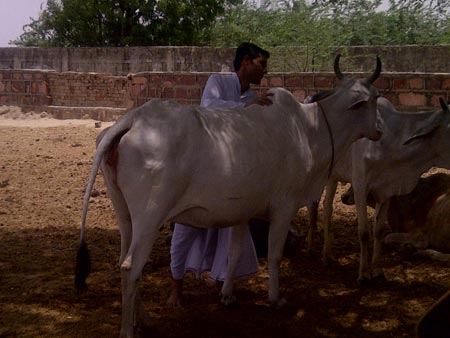News
Kalpavriksha Foundation recently organized the grand HOLY COW Festival in ISKCON Auditorium, New Delhi. Menaka Gandhi ji, Renowned Speakers, Goshalas and all the participants have appreciated a lot for this festival...
DOCTOR COW Gift Packs

Exclusively Gift Packs for Deepawali, X-mas, New Year, Marriages, Birthday.Gift Pack contains Pure Healthcare Products Cow Panchgavya, Organic & Dairy Products.
(Ordering of this Gift Packages would be one of the best CSR Initiative to support the noble cause of Cow Protection.)DOCTOR COW Product Store
Why DOCTOR COW Products are better :
-
* Mfd. under ISO & GMP Certified Co.
* Licensed by AYUSH, FSSI
* Prepared from panchgavya of indian breed cows
-
* Natural & Purest quality herbs used
* Ahimsa product
* Unified Brand to support ALL Goshalas
-
* Eco-Friendly and Eye-Catching Packaging
- * Profit goes for cow care
DOCTOR COW Products
Making Divine Cows Self Sustainable- * Personal Care Items
- * Home Care Items
-
* Nutrition & Health Items
-
* Cow Pathy Ayurvedic Medicines
- * Organic Products
* Pooja Items
* Vedic Gift Items
Indian Breed Cow Milk Products
India's Best Quality available for Puja, Gifting & Festivals- * Cow Milk Powder
- * Cow Ghee
- * Sweets - Peda
- * Sweets - Rasgulla
Cow's Education Material
-
* Books
-
* Magazines
-
* CD's / DVD's
-
* Technical Documents
-
* Promotion Material
Vedic Decoration For Walls
From Cow Dung by Brajwasi.
Best for your home, offices & workplaces. It brings Health, Wealth & Devotional Prosperity into life.
Cow : Photo & Paintings for Sale
(By world renowned Artists)Brings peace and abundance into your life. Purchase or Gifting of these photos & paintings will support a noble cause of cow protection.
(Click to view the Exclusive Collections)Comparision
Benefits of Indigenous Breed Cows over Hybrid Cows
Native/indigenous Breed Cows 12) It is assumed that while breathing, the native
breed leaves Oxygen in sufficient quantity which is
useful to human beings. |
Exotic breed/ Hybrid Cows 3) The bulls of exotic breed is inactive and not useful for agricultural work. They cross 2 km. in 19.4 minutes and their H.P. is also less. 7) This breeds can live in cold climate Only and can
not tolerate hot -climate. In hot-climate their productivity is reduced. The chances of their illness is more due
to which death can occur Native/indigenous breed.
|
Bank Details
A/c : KALPAVRIKSHA FOUNDATION
For Cow Products
Bank : BANK OF INDIA
Branch : HEL, Bhopal
Account No. : 900420110000778
IFS Code : BKID0009004
For GOSEVA Donation
Bank : CANARA BANK
Branch : BHEL, Bhopal
Account No. : 2544101016959
IFS Code : CNRB0002544
Opportunities for Cow Lovers
Objective Of Cow Campaign
-
Click for FREE Campaign Registration & GET Your GAU-SEVAK Code
Organize Cow Events / Seminars
Involve Cow Lovers as Volunteers/ Jobs/ Advisors
Tech. & Mkt. Support to Goshalas
Develop Gau-Pracharak & Gau-Palak
Promote & Distribute Cow Products
Serve & Earn through Gau-Seva
Upcoming Cow Events
-
Cow Pathy Health Seminars
Panchgavya, Organic & Dairy Training
GOSEVA for Health, Wealth & Devotion
Goshala Tour
Cow EDP Workshop
Cow Pathy Health Consultation
(By Cow Pathy Doctors)
* Dr.Aggarwal ji
* Shri Uttam Maheshwari
ji
* Dr. Shyam Purohit
ji
* Dr. Mukesh ji
* Dr. Niranjan Verma ji and many more ...
I OPTION : FREE
Email :
cowtherapy@kalpavriksha.info WhatsApp Message : +91-8839228679
II Option : PREMIUM.... (By Telephone / Personal Meeting, Register for PREMIUM Cow Pathy Health Consultation)
more >>
Information About Mother Cow
Kalpavriksha's Souvenir
Resource guide for Goshalas, Dairy, Organic Farmers, R&D Institutes & all Cow Lovers.
(Email your address to get FREE copy of Souvenir)Testimonials
I used Indian Breed Cow's ghee prepared from curd through traditional churning process with Indian Breed Cow's milk for 1 month, my weight got reduced by 5 kg.
Prem Priya Devi Dasi (ISKCON Devotee)
Cow's Medical & Ambulance Seva
Call for Sick or Injured Cows
9897198410 | 93023309459893944650 | 9412492975
9411201758 | 8273067755
9412432975 | 9911002200
9818434399 | 8630753722









.jpg)
.jpg)
.jpg)
.jpg)
.jpg)
.jpg)
.jpg)
.jpg)
.jpg)
.jpg)
.jpg)
.jpg)
.jpg)
.jpg)







.jpg)
.jpg)
.jpg)
Connect with KALPAVRIKSHA on: